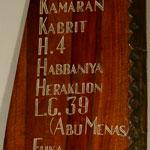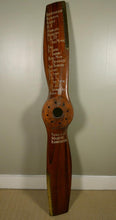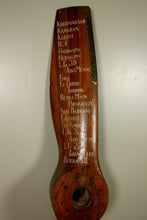A Royal Air Force 203 Squadron Propeller Trophy, 1940
- Regular price
- £1,650
- Sale price
- £1,650
- Regular price
-
- Unit price
- /per
Adding product to your cart
Length: 178cm (70in)
Laminated wood propeller with brass covered leading edge, tips cut down, from a 1930’s Regia Aeronautica Italiana Breda Ba.19 aerobatic and training biplane. Inscribed with the wartime stations and operating bases of No. 203 Squadron R.A.F. - ‘Khormaksar / Kamaran / Kabrit / Habbaniya / Heraklion / LG.39 (Abu Menas) / Fuka / El Gubbi (Tobruk) / Berka Main (Benghazi) / Sidi Barrani / Gambut / Bu Amud / L.G. X / LG.227 Gianclis / Berka III / Santacruz / Madura / Kankesanturai’.
The outbreak of the Second World War found 203 Squadron stationed on the Red Sea island of Kamaran before moving to RAF Khormaksar, Aden (present day Yemen).
Read More
The squadron had briefly deployed its Short Singapore III flying boats to Khormaksar four years earlier to deter raids on Aden and the Protectorates during crisis of September 1935 when Italy annexed Abyssinia. In early 1940, the squadron converted to Blenheim IV fighters, and, after Italy allied itself with Nazi Germany and declared war in June 1940, flew reconnaissance and fighter patrols over the Red Sea.
In April 1941, 203 moved to RAF Kabrit in the Suez Canal Zone to help to provide fighter cover for ships evacuating British and Allied troops from Greece. The squadron also utilized the airfield at Heraklion (Crete) which in May 1941 was overrun by German airborne forces. That same month, while continuing fly in support of the evacuation, a detachment was sent to help defend RAF Habbaniya (Iraq), which was then besieged by Iraqi forces controlled by the Arab nationalist Rashid Ali. During the short-lived Anglo-Iraq war the squadron also helped to defend the Transjordan branch of the Iraq Petroleum Company’s fuel line bringing oil from Iraq. On 9 May during an attack on the Iraqi held fort of Rutbah a 203 Blenheim touched down, rescued a pilot previously brought down by ground fire and took off at the approach of armoured cars. One of the squadron’s aircraft based on the pipeline was responsible for the first sighting of German aircraft in Vichy Syria, and on 14 May for the first bombing raid against those aircraft.
Towards the end of 1941 the squadron flew daily patrols between its Kabrit base in Western Egypt. A number of other airfields were used as advanced operating bases during this period, including El Gubbi in the Tobruk perimeter, Fuka, X-LG, Sidi Barrani, Berka and Abu Sueir. In April 1942 the squadron moved to bases in Egypt and Palestine, from where it took part in the invasion of Syria, then flew reconnaissance patrols over the Eastern Mediterranean. During the year the Blenheims were joined by Martin Maryland II’s (February) and then Martin Baltimores (August), before the squadron converted completely to the Baltimore IIIA’s and V’s.
During 1942 the squadron shared in the sinking of two U-boats. On 2 June U-652 was heavily damaged by aircraft from 203 Squadron and 815 Naval Air Squadron off Sollum, and was scuttled soon after the attack. On 4 August the squadron cooperated with the navy in the sinking of U-372.
In September - November 1943 the squadron moved through RAF Gianclis and Berka 3 (Egypt) to RAF Santacruz (Bombay, India) where it converted to the Vickers Wellington and began to fly coastal patrols. In October 1944 the Wellingtons were replaced with Liberators at RAF Madura (Madras) in February 1945 the squadron began to fly anti-submarine patrols from Kankesanturai (aka KKS) Ceylon. These were flown for the rest of the war. After the Japanese surrender the squadron performed transport duties, before returning to the UK in March 1946 where it converted to the Lancaster.
Khormaksar 203 May 1940-April 1941
Kamaran island - Aden
Kabrit 203 April-June 1941
H.4
Habbaniya 203 Iraq, may 1941 Beseiged
Heraklion 203 April 1941 EVACUATION OF CRETE
LG.39 Sidi Barrani (LG.39)
(Abu Menas)
Fuka 203 ADVANCED OPERATING BASE , LATE 1941
El Gubbi 203 January-February 1942
(Tobruk)
Berka Main
(Benghazi)
Sidi Barrani
203 advanced, late 1941
Gambut 203 February 1942: Gambut
Bu Amud
L.G. X 203 July-October 1942
Abu Sueir
LG.227 203 October 1942-March 1943
GIANACLIS 203 September 1942
BERKA 3 203 March-November 1943
SANTACRUZ 203 November 1943-October 1944
MADURA 203 October 1944-February 1945: Madur
KANKESANTURAI 203 February 1945-May 1946; 345 detachment






